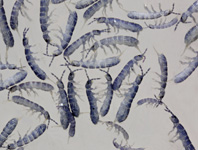Abstract
A new species of the family Qudsianematidae Jairajpuri, 1965 collected from soil from Qinghai Province, China is described as Discolaimus anemaqen n. sp. It is mainly characterized by having a disc-like lip region with six labial sectors separated by six Y-shaped radial grooves; amphid fovea an inverted-stirrup shape; odontostyle aperture 53–59% of its length; anterior part of pharynx with two swellings, basal part expanded gradually with a sheath of tissue visible ventrally and at the base; no groups of large cells observed in cardiac region; female genital system amphidelphic; tail dorsally convex, conoid, with flat ventral side and bluntly rounded terminus, and males not found. The new species is close to D. major Thorne, 1939, D. similis Thorne, 1939 and D. silvicolus Sauer & Annells, 1985 in most measurements, but can be differentiated from them by lip morphology, pharynx structure, body size, and tail shape. A key to the species of Discolaimus is also provided.
References
Abolafia, J. & Peña-santiago, R. (2005) Nematodes of the order Rhabditida from Andalucía Oriental: Pseudacrobeles elongatus (de Man, 1880) comb. n. Nematology, 7, 917–926.
http://dx.doi.org/10.1163/156854105776186415Andrássy, I. (1968) The scientific results of the Hungarian Soil Zoological Expedition to the Brazzaville-Congo, 31. Nematodes from Groundwater. Annales Universitatis Scientiarum Budapestinensis de Rolando Eötvös Nominatae (Sectio Biologica), 9–10, 3–26.
Andrássy, I. (1998) Once more: the oesophageal gland nuclei in the dorylaimoid nematodes. Opuscula Zoologica Budapestinensis, 31, 165–170.
Andrássy, I. (2009) Free-living nematodes of Hungary (Nematoda errantia). III. Pedozoologica Hungarica 5. Hungarian Natural History Museum and Systematic Research Group of the Hungarian Academy of Sciences, Budapest, 608 pp.
Cobb, N.A. (1913) New nematode genera found inhabiting fresh water and non-brackish soils. Journal of the Washington Academy of Sciences, 3, 432–444.
http://dx.doi.org/10.5962/bhl.part.20323Coomans, A. (1966) Some nematodes from Congo. Revue de Zoologie et Botanie Africaines, 74, 287–312.
Furstenberg, J.P. & Heyns, J. (1965) Four new species of the genus Discolaimus Cobb, 1913 (Nematoda: Dorylaimoidea) from South Africa, with a description of the male of D. similis Thorne, 1939. Nematologica, 11, 467–479.
http://dx.doi.org/10.1163/187529265X00645Gantait, V.V., Bhattacharya, T. & Chatterjee, A. (2009) A new species of the genus Discolaimus Cobb, 1913 (Qudsianematidae: Dorylaimida) from West Bengal, India with revised key to the genus. Proceedings of the Zoological Society, 62, 67–73.
http://dx.doi.org/10.1007/s12595-009-0009-1Gao, Y., Lv, Y., Gu, X. & Zhang, W.D. (2012) Community structure of soil nematodes around the plant rhizosphere in Dalian Xishan reservoir. Tianjin Agricultural Sciences, 18, 102–105.
Heyns, J. (2000) The genus Discolaimus in southern Africa. 1. Introduction and redescription of D. Krugeri Furstenberg & Heyns, 1966 (Nematoda: Dorylaimida). Koedoe, 43, 7–15.
http://dx.doi.org/10.4102/koedoe.v43i2.195Heyns, J. (2001) The genus Discolaimus in southern Africa. 2. Discolaimus constrictus sp. n. and D. Monoplanus Heyns, 1963 (Nematoda: Dorylaimida). Koedoe, 44, 47–56.
http://dx.doi.org/10.4102/koedoe.v44i2.173Khan, H.A. (1998) A new species of Discolaimus Cobb (Nematoda: Discolaimidae) with the description of two other species from Pakistan. Bangladesh Journal of Zoology, 26, 13–18.
Li, Q., Jiang, Y., Liang, W.J., Wang, H. & Jiang, S.W. (2009) Nematode diversity in phaeozem agroecosystems of Northeast China. Pedosphere, 19, 597–605.
http://dx.doi.org/10.1016/S1002-0160(09)60154-5Loof, P.A.A. (1964) Free-living and plant-parasitic nematodes from Venezuela. Nematologica, 10, 201–300.
http://dx.doi.org/10.1163/187529264X00042Nasira, K., Shahina, F. & Erum, Y.I. (2008) Description of Discolaimus pakistanense n. sp. (Nematoda: Dorylaimida) with a compendium of the genus Discolaimus Cobb, 1913 from Pakistan. Pakistan Journal of Nematology, 26, 107–124.
Peña-Santiago, R., Torres, B., Liébanas, G. & Abolafia, J. (2002) Nematodes of the order Dorylaimida from Andalucía Oriental, Spain. The genus Discolaimus Cobb, 1913. II. Two previously known species, with comments on their taxonomy. Russian Journal of Nematology, 10, 79–88.
Sauer, M.R. & Annells, C.M. (1985) Species of Discolaimus (Nematoda: Dorylaimoidea) from Australia. Nematologica, 31, 121–133.
http://dx.doi.org/10.1163/187529285X00175Siddiqi, M.R. (2005) Ten new species of Discolaimus Cobb, 1913 (Nematoda: Dorylaimida). International Journal of Nematology, 15, 215–229.
Song, M. & Jing, S.S. (2015) Soil nematode diversity in semiarid steppe of Northern China. Journal of Henan University (Natural Science), 45, 581–586.
Thorne, G. (1939) A monograph of the nematodes of the superfamily Dorylaimoidea. Capita Zoologica, 8, 1–261.
Whitehead, A.G. & Hemming, J.R. (1965) A comparison of some quantitative methods of extracting small vermiform nematodes from soil. Annals of Applied Biology, 55, 25–38.
http://dx.doi.org/10.1111/j.1744-7348.1965.tb07864.xWu, J.B., Ruan, W.B., Zhang, X., Li, J., Guo, H.Y., Li, J. & Gao, Y.B. (2008) Diversity of soil nematode communities in roots of Caragana Fabr. in the Inner Mongolia Plateau, China. Chinese Journal of Applied and Environmental Biology, 14, 624–629.
Wu, W.J., Yan, L., Xu, C.L., Wang, K., Jin, S.Y. & Xie, H. (2015) Morphology and morphometrics of Heterodorus qinghaiensis n.sp. (Dorylaimida, Nordiidae) from soil samples in China. Journal of Helminthology, 1–17. [published online 22 June 2015]
http://dx.doi.org/10.1017/S0022149X15000358
Xie, H. (2005) Taxonomy of plant nematodes. 2nd Edition. Higher Education Press, Beijing, 435 pp.
Xue, H.Y., Hu, F. & Luo, D.Q. (2013) Effect of plant community on soil nematode community in alpine meadows in North Tibet. ACTA Pedologica Sinica, 50, 507–516.
Xu, B., Ren, H.Q., Zhao, N,X., Ruan, W.B. & Gao, Y.B. (2015) Community analysis of soil nematodes associated with four grassland species in the Inner Mongolian steppe. Chinese Journal of Ecology, 34, 175–181.
Zhong, S., He, Y.D., Han, L.N., Zhou, Z.X., Ma, W.H., Zeng, H.C. & Jin, Z.Q. (2012) Effect of continuous cropping of banana on soil nematode community structure and diversity. Chinese Journal of Eco-Agriculture, 20, 604–611.
http://dx.doi.org/10.3724/SP.J.1011.2012.00604Zhong, S., Zeng, H.C. & Jin, Z.Q. (2015) Responses of soil nematode abundance and diversity to long-term crop rotations in tropical China. Pedoshpere, 25, 844–852.
http://dx.doi.org/10.1016/S1002-0160(15)30065-5

